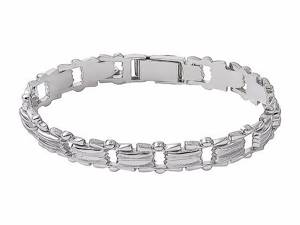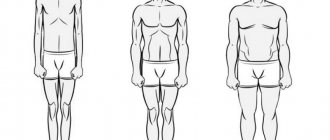The bracelet is a wonderful gift not only for yourself, but also for your loved one, friend, girlfriend, colleague. Such jewelry is easy to choose, regardless of what your loved one’s hobbies are, where they work, or what they look like.
After all, a wide range of modern bracelets allows you to make a gift that is guaranteed to be successful, to choose exactly the product that will harmoniously complement a person’s image, emphasize his hobbies, or become a romantic reminder of your relationship, of memories that are important to both of you.
If you're buying jewelry for yourself, determining the size is easy, but what if you don't know the size of the person you want to give it to?
brand has compiled a detailed guide on how to determine the size of a bracelet, even without a ruler or measuring tape, to make every purchase a success!
How to choose a bracelet size the classic way
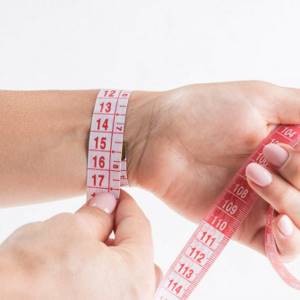
The main parameter is wrist circumference. Constantin Nautics bracelets are created in a full range of sizes: from 15 to 21 centimeters. But if necessary, we meet clients’ needs and make exclusive jewelry in the required size - less than 15 or more than 21.
To determine the desired size in the classic way, you need to measure the circumference of your wrist along the protruding bone using a measuring tape.
If you don't have a measuring tape at hand, regular thread will help you. Take a measurement with it, and then measure the thread with a ruler or tape measure. Add 3-5 mm of free margin - the resulting value is the bracelet size you need .
The length of the bracelet itself, without the lock, is taken into account.
The average wrist circumference for women with a normal build is considered to be about 16-17 cm, and for men - 19-20 cm.
If the size of the wrist jewelry is chosen correctly, a finger should fit freely between the strap and the wrist.
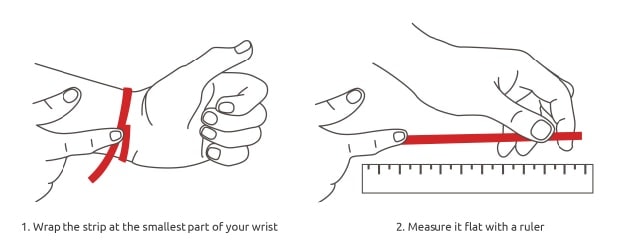
According to statistics, women's wrist circumference varies from 14 to 19 cm. To quickly figure out what size you need, check out the table of women's sizes for jewelry bracelets.
For a woman's hand:
| Wrist circumference, cm | Bracelet size with lock, cm | Marking | Size Constantin Nautics |
| 14-15 | 15-16 | XS | 15 cm |
| 15-16 | 16-17 | S | 16 cm |
| 16-17 | 17-18 | M | 17 cm |
| 17-18 | 18-20 | L | 18 cm |
| 18-19 | 20-21 | XL | 19 cm |
| Body type | Approximate weight | Statistical brush size |
| Skinny | Up to 50 kg | Up to 15 cm |
| Fragile beauty | Up to 60 kg | Up to 15-16 cm |
| Girl of average build | Up to 80 kg | 16-18 cm |
| Appetizing charmer | More than 80 kg | More than 18 cm |
The size of a men's bracelet can be determined very simply by using the table of men's wrist bracelet sizes.
For a man's hand
| Wrist circumference, cm | Bracelet size with lock, cm | Marking | Size Constantin Nautics |
| 16-17 | 18 | S | 17 cm |
| 17-18 | 19 | M | 18 cm |
| 18-19 | 20 | L | 19 cm |
| 19-20 | 21 | XL | 20 cm |
| 20-21 | 21-22 | XXL | 21 cm |

Women's US Sizes/Widths
| US Size | Narrow | Average | Wide | X-Wide |
| 5 | 2.81 | 3.19 | 3.56 | 3.94 |
| 5.5 | 2.88 | 3.25 | 3.63 | 4 |
| 6 | 2.94 | 3.31 | 3.69 | 4.06 |
| 6.5 | 3 | 3.38 | 3.75 | 4.13 |
| 7 | 3.06 | 3.44 | 3.81 | 4.19 |
| 7.5 | 3.13 | 3.5 | 3.88 | 4.25 |
| 8 | 3.19 | 3.56 | 3.94 | 4.31 |
| 8.5 | 3.25 | 3.63 | 4 | 4.38 |
| 9 | 3.31 | 3.69 | 4.06 | 4.44 |
| 9.5 | 3.38 | 3.75 | 4.13 | 4.5 |
| 10 | 3.44 | 3.81 | 4.19 | 4.56 |
| 10.5 | 3.5 | 3.88 | 4.25 | 4.63 |
| 11 | 3.56 | 3.94 | 4.31 | 4.69 |
| 11.5 | 3.63 | 4 | 4.38 | 4.75 |
| 12 | 3.69 | 4.06 | 4.44 | 4.81 |
| 12.5 | 3.75 | 4.13 | 4.5 | 4.88 |
| 13 | 3.81 | 4.19 | 4.56 | 4.94 |
| 13.5 | 3.88 | 4.25 | 4.63 | 5 |
| 14 | 3.94 | 4.31 | 4.69 | 5.06 |
You can measure the width by the imprint/pattern of your foot, at the widest point of the toe box. I got 3.6 inches. The size, as I determined above, is 7, which means it’s about average width, a little wider. Given that normal shoes stretch a little, this means average. These sizes may not be needed very often.
Climb
can be visually determined. We don't need him for anything else - purely for fun.
How should a bracelet fit on your hand?
There are no strict rules about this, it all depends on the personal preferences of the owner of the bracelet, but there are still some nuances:
- If the product is made of metal, it should move freely along the hand; it can be 1 - 2 cm longer than the circumference of the wrist.
- If the product is made of leather, it can fit snugly on the arm, but not impede free blood flow or cut into the skin. Try to get your little finger under the bracelet; if it fits, it means the size is perfect.
- Bracelets made from chains are chosen to be 2-3 cm larger, they should not tighten the hand, free “sagging” is only welcome.
Despite the generally accepted line of sizes, there are brands that adhere to their own separate grid.
For example, contrary to the logical rule: wrist circumference in centimeters = bracelet size in centimeters, the Pandora brand went its own way and there is an explanation for this: when adding charms to the base of the bracelet, it decreases in girth.
Therefore, in order to correctly determine the required size, and not find out with surprise that it has become too small for you, you need to add 2-3 centimeters to the resulting wrist circumference. If the measurements are on the border of two sizes, proceed from how you plan to wear the bracelet. If you want to add lots of charms, choose a larger size. If you want to get by with one or two additional elements, you can choose a smaller size.
According to statistics, the most popular size of a Pandora bracelet is 19 centimeters (i.e. the usual 17th). It is important to remember that Pandora bracelets may stretch a little when worn - over time they become more flexible and can become up to 1 cm longer.

Life hacks: how to secretly find out your bracelet size
If it’s still difficult for you to determine the size of a woman’s or a man’s bracelet based on your type, and you are afraid of making a mistake with your choice, you can use our clever life hacks.
Method #1: Observational
This is the easiest way to find out the right bracelet size. Pay attention to the cuffs of the shirt, blouse, jacket of the person to whom you are going to give a nice gift. If the cuffs fit snugly enough to your arm, you can use their girth as a reference for the size you need. Choose a convenient time and calmly measure the cuffs, the resulting number will be the desired one.
Method #2: Obvious
Does your loved one wear a watch? Then half the job is done. If this watch is on a chain bracelet, simply measure its length. Does your loved one wear a watch on a leather strap? Keep track of which hole he fastens them to, measure the length and add 1 cm to be safe. Done.
Method number 3: Gentle
The method is controversial, but sometimes effective. Grasp the person’s wrist (casually, just like that) with your fingers and remember where they meet. Measure this distance as soon as possible.
Method number 4: Dangerous
If the future lucky owner of the bracelet is an enviably sound sleeper, you can simply measure his wrist with a thread, and then measure it with a ruler or measuring tape. But be careful and prepare an explanation for your strange behavior in advance, in case your other half suddenly awakens
Helpful information
5.1 Sizes of bracelets from Western manufacturers
Wanting to place an order from a foreign one, because unlike Russian ones, Western brands indicate the size of bracelets in inches. To find out your size, you simply multiply your size in centimeters by 2.54.
Also, Western manufacturers often offer to choose the size of the bracelet according to the size of the person’s clothing. Below is the correspondence table.
| Clothing size | Bracelet length in inches |
| Petite (very small) | 7 |
| S (small) | 7,25 |
| M (medium) | 7,5 |
| L (large) | 7,75 |
| XL (extra large) | 8 |
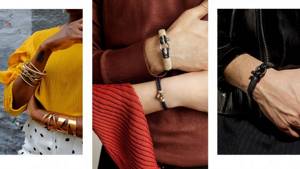
5.2 Types of bracelets
All bracelets can be divided into soft and hard. Rigid bracelets (bangle) do not bend, can be with a clasp and fit tightly to the hand, or without a clasp, the hand fits into them freely, but the bracelet does not fall off.
Soft bracelets are the most popular and there are many more varieties of them.
Types of hard bracelets
- Rim bracelets are rigid thin or wide bracelets that can be closed or in the form of an open ring.
- Cuff bracelets are very wide metal or leather bracelets that resemble, as the name suggests, sleeve cuffs.
- Snake bracelets look like springs and seem to entwine your hand. These are often decorated with various stones and inserts.
- Charm bracelets are a rigid base designed for stringing charms.
Types of soft bracelets
- Chain bracelets are the most common type of jewelry, worn by both men and women with equal success. Thanks to the varied weaving, the chains can differ in texture and pattern. Among the varieties of weaving: anchor (the links are made in the form of an anchor chain), belzer (the round shape of the links), snake (the chain pattern resembles a snake pattern), rhombo (diamond-shaped links), cartier (the elements have different sizes and alternate in a certain sequence) and etc.
- Slave bracelet - put on the hand and connected by a chain with a ring on one or two fingers.
- Leather bracelets are a great option for everyday wear. They can be a smooth strip of leather, a textured braided lace, or an interweaving of several laces.
- Charm bracelets - a prominent example - Pandora bracelets, are a base and a variety of charms or pendants that can be worn depending on the occasion and mood.
- Red thread - a protective thread from Israel has become not just an amulet, but a fashionable modern decoration. It is often complemented with various pendants.
- Shambhala is a bracelet with large beads made of natural or non-natural stones. Such bracelets are considered not just decoration, but, like bracelets with a red thread, they are modern amulets that affect certain areas of a person’s life.

5.3 Types of fasteners
If you are still not sure that you can correctly determine the size of the bracelet, you can always purchase a model with an adjustable clasp. A huge assortment of modern bracelets will not limit your choice, and you can make a successful gift.
But if you still find out the desired bracelet size, then the field of choice becomes even wider; you can choose a bracelet with any clasp.
- The truss mechanism is a round lock with a spring latch. This type of clasp is often used in miniature and thin bracelets. A lightweight lock does not overload the design, but may not be very convenient to use due to its size.
- Carabiner is one of the most popular types of fasteners. Looks like a hinge with a spring clip. This lock is considered durable, reliable and easy to use; with some skill, it can be opened even with one hand.
- Box lock - consists of a miniature box with a hole and a latch; it is used quite rarely and mainly when the design involves a secret lock that does not stand out from the overall design.
- A hinge lock is a movable connection between two parts of a bracelet using a special pin.
- A buckle lock is a folding lock whose operating principle is based on a hinge and a latch.
- Screw lock - looks very aesthetically pleasing and fits easily into almost any design, but it can come loose if the thread is weak.
- The toggle clasp is an interesting type of clasp, the system of which consists of a T-shaped pin inserted into a large link of the bracelet. Thanks to natural tension, this lock securely fixes the bracelet on your hand.
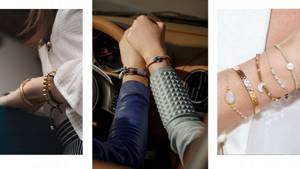
5.4 How to wear bracelets
There are no strict rules for bracelet owners; modern trends have proven that bold decisions lead to amazing results. Street-style images show us this. Bracelets are worn with anything and anywhere, play with contrasts and experiment with combinations.
But there are still some tips that have been developed over the years.
- For people with thin wrists and graceful hands, almost all bracelets are suitable, except very massive ones, which can create the effect of shackles.
- Large bracelets that are visible on the hand are well suited for ladies with a larger body. If desired, they can be replaced by several thin products.
- It is better not to create unnecessary competition between the ring and the bracelet. If you want to wear both jewelry at the same time, then wear them on different hands, so the image will not be overloaded with unnecessary details.
- Make sure that the bracelet does not clash with the overall mood of the other jewelry in the look. For example, a nautical bracelet will visually clash with tassel earrings.
- A thin hard bracelet or a classic chain will add elegance to a strict business image.
- If you are the happy owner of a brightly designed bracelet, let it be the focal point of your look and exclude other jewelry.
- To wear a bracelet, men just need to have well-groomed hands, but girls should think in advance which color of varnish will suit the jewelry you choose in order to emphasize the beauty of the bracelet and the elegance of their hands.
- If you want a universal bracelet that matches any outfit in your wardrobe, opt for simple items made of metal or leather in basic shades. Such jewelry is suitable for both an office wardrobe and everyday wear.
- Mixing two different metals in one image is bad form... it used to be like that. Now fashionistas have ventured into bold experiments and easily wear gold bracelets with silver chains, silver earrings with gold belt buckles. The main thing is a sense of harmony.
- Another rule that has lost its relevance: jewelry must be worn as a set. It's the same as shoes and a handbag of the same color. Boring! Demonstrate to others your ability to harmoniously choose jewelry that is not included in one set.
- To prevent the bracelet from getting lost, try to find a decent frame for it; a bare arm or a tight-fitting jumper sleeve is the best choice. But sleeves with ornaments, embroidery, patterns or large prints will clearly distract attention from the decoration and overload the image.
-10%Hit
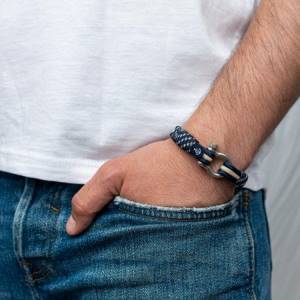
Close
Marine bracelet beige-blue for men and women - No. 5040
Rating 4.80 out of 5
RUB 2,899.00 RUB 2,609.10
Add to favorites
Choose …
Quick view
-10%
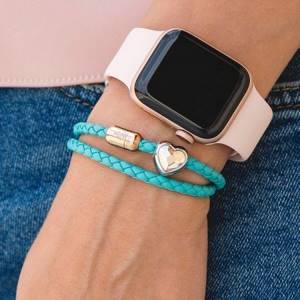
Close
Bracelet made of genuine leather with Swarovski stone – No. 7227
Rating 4.71 out of 5
RUB 5,799.00 RUB 5,219.10
Add to favorites
Choose …
Quick view
-10%Hit

Close
Marine bracelet red white and blue - No. 3014
Rating 5.00 out of 5
RUB 2,899.00 RUB 2,609.10
Add to favorites
Choose …
Quick view
5.5 How to care for bracelets
... made of silver
You can quickly return a silver bracelet to its previous appearance by boiling it in a special solution of water and soda, add a piece of foil to it and immerse the jewelry. The reaction of silver sulfide with soda and aluminum will quickly remove the darkening from the bracelet.
… leather
Such products should not be exposed to the sun for long periods of time, otherwise microcracks may appear. For the same reason, if the bracelet gets wet, dry it naturally, away from heat sources.
... from textiles
Used Constantin Nautics flaps can be washed in a regular washing machine. Before washing, remove the metal fasteners. If they cannot be removed, then it is better to wash them by hand.
... made of metal
Constantin Nautics bracelets stainless steel, it is safe and non-toxic. If small stains appear on metal parts, simply wipe them with a regular cloth.
Main models
A bracelet is a classic piece of jewelry that is worn on the hand. Being widely known since Paleolithic times, it was present in the cultures of various peoples. It was assumed that wearing special hoops on the wrists could protect against evil spirits, damage and the evil eye, and all kinds of troubles and adversities.
These unique accessories have not lost their relevance today, being divided into several types and categories. Thus, bracelets are usually distinguished by:
- shape - spiral, round (hoops), bracelets-clips, bracelets-half-rings and bracelets-chains;
- material – gold, silver, platinum or costume jewelry;
- manufacturing method - closed, hinged, chain, spring, braided.
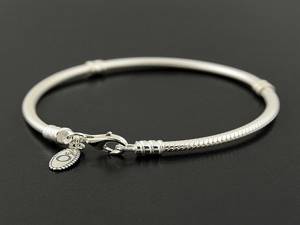
Chain accessories are those made by connecting chain links in series.
Hinged - those that are secured using a special hinge.
Closed - one-piece bracelets that do not have additional fasteners or inserts.
Spring - tightly wrapping around the hand, stretching under mechanical influence. Made on the basis of elastic threads.
Braided - made on the basis of beads or beads by stringing.
